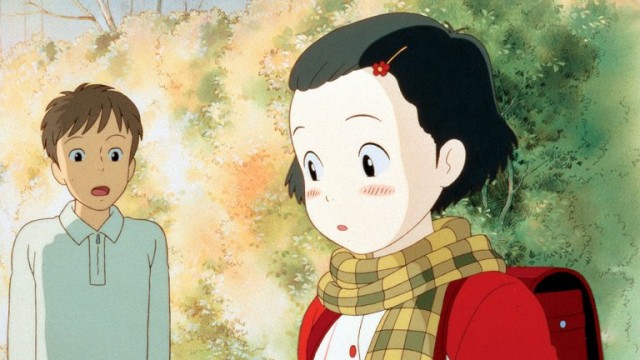When Hayao Miyazaki’s My Neighbor Totoro was originally released in 1988, it was a double feature with Isao Takahata’s Grave of the Fireflies. On the surface, the two films are opposites: Totoro is a childlike fantasy of rural Japan dealing with a new life and a mother’s long-term illness while Fireflies is a somber look at the after effects of war on two children. On a deeper level, they’re a yin and yang, two opposite anti-war statements from the perspective of children.
In a sense, that describes the relationship of the two directors. Miyazaki approaches his movies with a childlike sense of wonder and possibility, while Takahata is far more interested in what has been and how they effect the present. Miyazaki has his head in the air, and Takahata has his feet on the ground. Miyazaki tends to feel more innocent and positive while Takahata can tend to get bogged down in the negatives.
Isao Takahata’s 1991 film, Only Yesterday, is Japan struggling with its past and present, dealing with a need to compete in the western world, but still navigating an all too fast culture change. 27-year-old Taeko is a single working woman in Tokyo at a cross-roads in her life. Unhappy with the big city but reluctant to try rural life, Taeko visits her sister in rural Yamagata while assessing her life, focusing on her childhood school trip to the countryside.
This is Only Yesterday‘s first official stateside release, though it was toured with subtitles as part of the Studio Ghibli retrospective in 2013. Today, in a world where anime has finally come into its own as a genre for adults, it’s probably an easier sell than it was 25 years ago when animation was primarily seen as a medium for kids. Though appropriate for older children, Yesterday is aimed at young women and adults, dealing with adult themes of memory and regret, decisions and consequences, innocence and maturity. In a sentence, Judy Blume gets swept up into a Hallmark Channel romance.
Takahata’s animation style combines lush watercolor and sketch-like characters to achieve a Highlights Magazine-level of nostalgia bordering propagandic. The style fits magnificently with the story line of a woman dealing with her spinsterhood and having a crisis stemming from the big city being too stressful and unrewarding for her. Only Yesterday isn’t shy about pushing its rural agenda, where life is slower and love and family are more plentiful (to be fair, no Studio Ghibli film is ever shy about pushing whatever that film’s agenda is). Whether or not Yesterday is arguing that Taeko is best defined through her relationship with new love interest Toshio, the struggle between modernity and tradition is real (for men and women).
Because this was made in 1991 Japan, but released in 2016 America, Takahata’s traditionalist intent is difficult to dismiss. While Taeko is a lovingly complicated character, the mechanics of adult Taeko’s story – that is, the parts of the story added by Takahata – feels almost-dated in the modern era. 25 years after Only Yesterday was originally released, men and women in Tokyo are taking smaller apartments and living independent and celibate lives to the point that news stories call it a population crisis. Against the current atmosphere of fierce independence in the face of work-related ambition, Only Yesterday feels more simultaneously prescient and like an old man spinning yarns about the good old days.
Modern societal concerns aside, if Only Yesterday is propaganda, then it’s the best kind of lovingly detailed propaganda. If only filmmakers always wooed with such grace and skill. Thematic anecdotes – such as a big city family waiting a week to eat a fresh pineapple only to discover it doesn’t taste as sweet as the canned pineapple to which they’re accustomed – color the background more than direct recitation would. Only Yesterday is the most nuanced schmaltz one could desire, using memory and nostalgia to critique, color, and comment on the past and the present. If only more movies realized this was possible.

